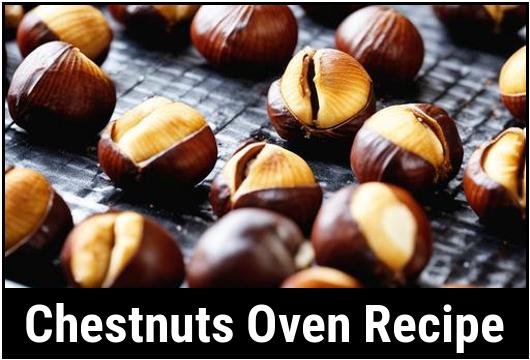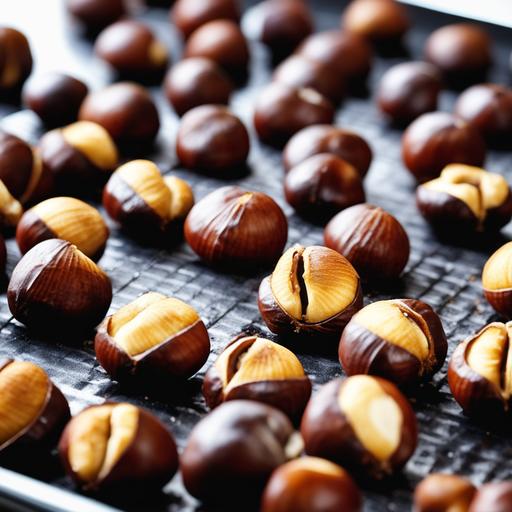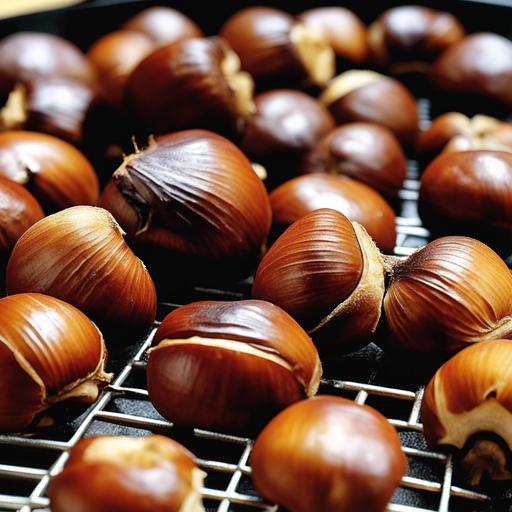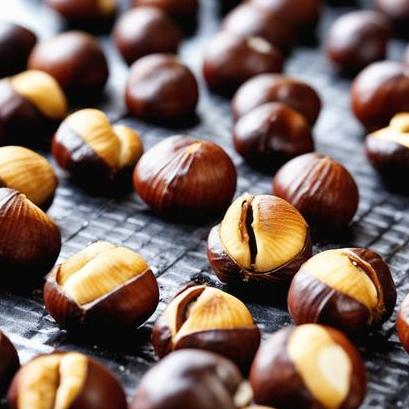
The Ultimate Chestnuts Oven Recipe: Unleashing The Flavors Of Autumn
Discover the Science, Culinary Techniques, and Irresistible Recipe!
As the crisp autumn air carries the scent of fallen leaves and cozy fires, there is one treat that captures the essence of the season—the humble chestnut. Roasting chestnuts in the oven is an age-old tradition that fills our homes with warmth and our hearts with joy. In this comprehensive guide, we will explore the science behind chestnut roasting, learn culinary secrets, discover the best practices for selection and preparation, explore exciting variations, and finally, rustle up an unforgettable chestnut feast. So, roll up your sleeves, gather your ingredients, and let’s dive into the captivating world of chestnuts!
The Science Behind Chestnut Roasting
Understanding the science behind chestnut roasting is essential to achieve the perfect texture and flavor. Unlike other nuts, chestnuts have a high moisture content, making them a unique culinary delight. The heat from the oven triggers a series of complex chemical reactions that transform raw chestnuts into tender, creamy morsels. The oven’s dry heat drives off the moisture and caramelizes the natural sugars within, enhancing their nutty sweetness. Excitingly, the high starch content in chestnuts gives them a remarkable ability to convert into a velvety texture akin to a potato. Mastering the art of chestnut roasting requires a delicate balance of heat, time, and attention.
Selecting the Finest Chestnuts
To create a masterpiece, start with the finest ingredients. When selecting chestnuts, look for smooth, glossy shells without any visible cracks or holes. A blemish-free appearance is a positive indicator of freshness. For optimal results, opt for chestnuts that feel heavy for their size, suggesting they are plump and moist. Larger chestnuts are generally easier to peel and boast a more pronounced flavor. Remember, the quality of your chestnuts sets the stage for an extraordinary culinary experience.
Cleaning and Preparation

Before roasting chestnuts, a thorough cleaning is vital to ensure their natural brilliance shines through. Begin by rinsing them under cool water, removing any debris or dirt clinging to the shells. Next, take a sharp knife and make an incision, crisscrossing each chestnut. Be sure to penetrate through the shell but not too deep into the flesh to prevent splitting during roasting. This allows steam to escape, preventing violent explosions inside the oven. Nurturing your chestnuts with care at this stage guarantees a seamless roasting process.
Tips for Perfect Roasting

Roasting chestnuts is an art form that requires patience and attention to detail. Here are some tips to achieve chestnut perfection:
- Preheat and Pamper: Preheat your oven to 425°F (220°C) to establish an initial burst of heat that will encourage proper roasting. It is important to bake chestnuts in a single layer to ensure even cooking. Pamper them by overlaying a damp kitchen towel, creating a steamy environment that softens the shells.
- Timing is Key: Roasting time varies depending on chestnut size, moisture content, and oven characteristics. As a general guideline, roast medium-sized chestnuts for 20-25 minutes, while larger ones may require an additional 5-10 minutes. Remember, the true measure of doneness lies in the chestnuts’ taste and tenderness, so be sure to sample along the way.
- Taking a Peek: Curiosity is welcome when it comes to chestnut roasting! Occasionally, open the oven door and carefully check the progress. The perfect chestnut will yield to gentle pressure when squeezed between your fingers. However, exercise caution while testing, as they retain heat and could burn your fingers if still too hot.
- Patience, Patience, Patience: Sometimes impatience can tempt us to undercook or overcook our precious chestnuts. Allow them to roast gradually, embracing the tantalizing aroma that fills your kitchen. Remember, the magic unfolds through patience and a little extra time.
Variations on the Chestnut Theme

While roasted chestnuts are delightful on their own, experimenting with flavors can elevate them to new culinary heights. Here are a few variations to tantalize your taste buds:
- Sweet and Spicy: Impress your guests by tossing roasted chestnuts in a blend of cinnamon, nutmeg, and a pinch of cayenne pepper. This fusion of flavors adds a delightful twist to the classic roasted chestnut.
- Herb-infused Chestnuts: Before roasting, toss your chestnuts in a medley of fresh rosemary, thyme, and a drizzle of olive oil. The aromatic herbs infuse the chestnuts with fragrant notes that complement their natural sweetness.
- Savory Delights: For a more savory option, sprinkle your roasted chestnuts with a touch of sea salt, cracked black pepper, and a hint of garlic powder. The contrasting flavors will leave your taste buds dancing with joy.
Feel free to experiment with your own flavor combinations—chestnuts are incredibly versatile and lend themselves to a myriad of culinary adventures.
Checking Doneness – The Chestnut Quest

Determining whether your chestnuts are cooked to perfection requires a keen eye and a willingness to embark on the chestnut quest. After your estimated cooking time, remove a chestnut from the oven and let it cool slightly. Gently taste and evaluate its texture. The ideal chestnut should peel effortlessly, revealing a creamy, tender interior that melts in your mouth. If the texture is still slightly firm or starchy, return them to the oven for a few more minutes until perfection is achieved. Remember, practice makes perfect, and each chestnut cooking session is an opportunity to refine your skills.
The Chestnuts Oven Recipe: Step-by-Step Instructions
Now that you have delved into the science, culinary techniques, and flavor variations, it’s time to put your knowledge to the test with this tantalizing chestnut oven recipe:
Ingredients:
- Fresh, high-quality chestnuts
- Water (for rinsing)
- Damp kitchen towel (to overlay)
- Choice of flavor variations (optional)
Instructions:
- Preheat your oven to 425°F (220°C).
- Rinse the chestnuts under cool water to remove any dirt or debris.
- Using a sharp knife, make a shallow crisscross incision on the flat side of each chestnut.
- Arrange the chestnuts in a single layer on a baking sheet.
- Lightly dampen a kitchen towel and place it over the chestnuts to create a steamy environment.
- Bake in the preheated oven for 20-25 minutes, or until the chestnuts are tender.
- Occasionally check for doneness by squeezing a chestnut between your fingers. If it yields easily under gentle pressure, it is ready. If not, return them to the oven for a few more minutes.
- Once cooked, allow the chestnuts to cool slightly before peeling.
- Serve warm and enjoy the exquisite flavors of autumn!
Beware of Overcooking and Undercooking
As with any culinary endeavor, caution must be exercised to avoid overcooking or undercooking your chestnuts. Overcooking can result in a dry and mealy texture, robbing them of their natural allure. Conversely, undercooked chestnuts can be starchy and difficult to peel, leaving you yearning for that perfect creamy bite. Remember, practice is key—fine-tuning the cooking time with each attempt will help you achieve chestnut nirvana.
A Final Word
Roasting chestnuts in the oven is a time-honored tradition that embodies the essence of autumn. From the science behind the roasting process to culinary techniques, flavor variations, and achieving perfect doneness, you are now equipped with the knowledge to embark on your chestnut adventure. So, gather your loved ones, savor the magical aromas, and indulge in the unforgettable experience of consuming warm, tender chestnuts. Embrace these delicious autumn jewels and let your culinary talents shine!
Note: Chestnut roasting is a seasonal treat, so savor the fleeting moments of autumn’s bounty and relish in the flavors nature gifts us.
Sources
FAQS On Chestnuts Oven Recipe
Can I Roast Chestnuts In Any Oven?
Yes, you can roast chestnuts in any oven. However, it’s important to choose the right temperature and cooking time for the best results.
How Do I Know When The Chestnuts Are Done?
You can tell when the chestnuts are done by checking the color of the skin. When the skin begins to peel back, the chestnuts are ready. You can also test one by cutting it open and checking the texture of the nut.
Should I Soak The Chestnuts Before Roasting Them?
It’s recommended to soak the chestnuts in cold water for at least 30 minutes before roasting them. This will help make them softer and easier to peel.
Can I Add Seasoning To The Chestnuts Before Roasting Them?
Yes, you can add seasoning to the chestnuts before roasting them. Some popular seasonings include salt, pepper, herbs, and spices. You can also add butter or oil for extra flavor.
How Should I Store Leftover Roasted Chestnuts?
If you have leftover roasted chestnuts, store them in an airtight container in the refrigerator for up to four days. You can also freeze them for up to six months. Reheat them in the oven or on the stovetop before serving.


